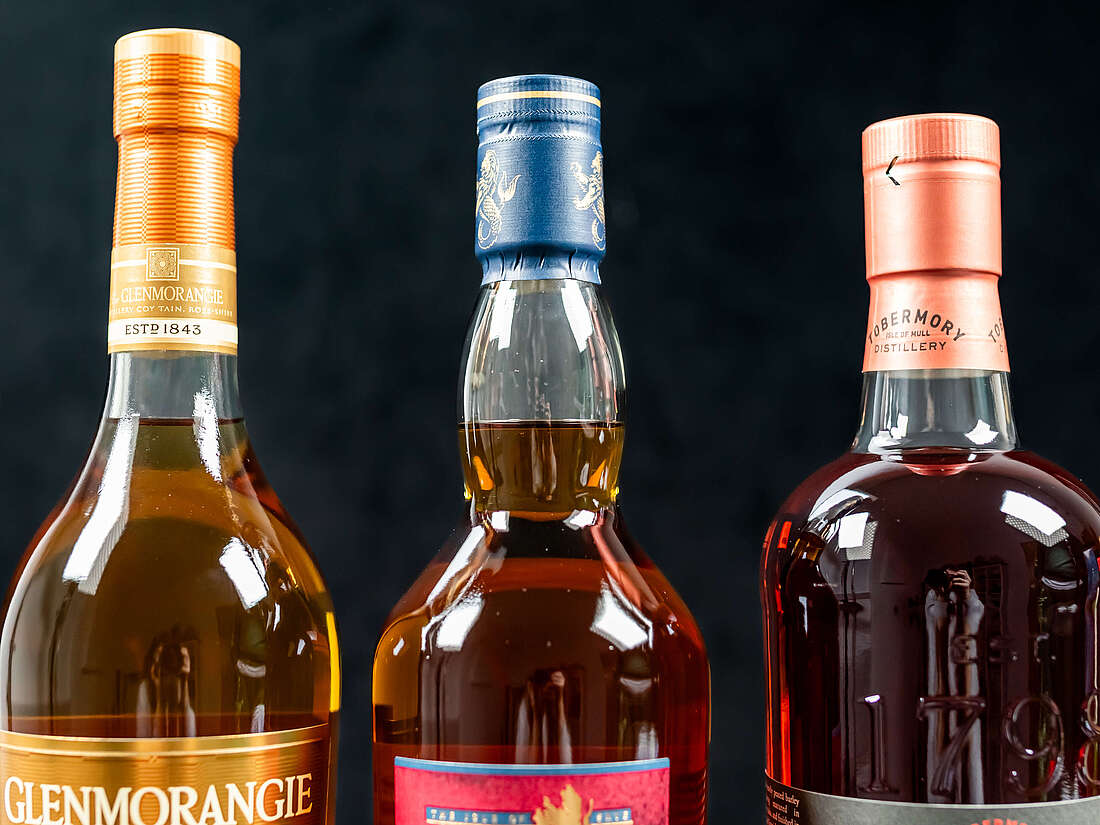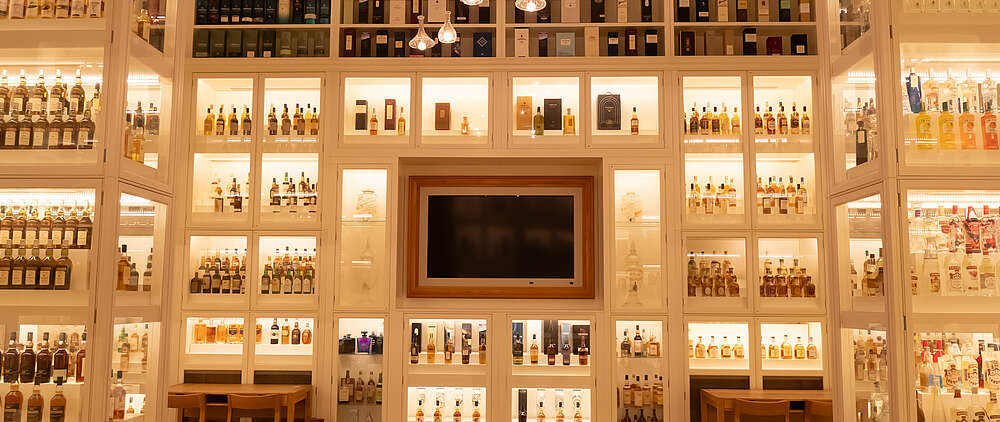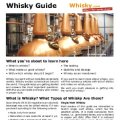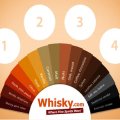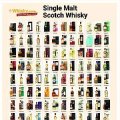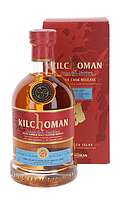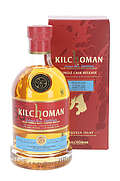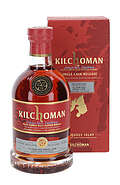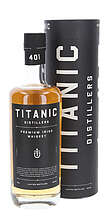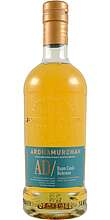The colour of the whisky
Amber in colour! That already sounds like a full flavour!
The colour of the whisky ranges from the clear Glen Kella to the black Loch Dhu. The colour can be an interesting criterion for describing a whisky.
Whisky often has a wonderful colour. Here you can learn about the chemical background of how the natural colouring in whisky is created. We also look at the colouring of whisky with caramel as a colouring agent, which is common practice at some distilleries.
Where does the colouring come from?
The fresh distillate is a clear liquid. The colouring agents only enter the spirit during maturation in oak barrels. During this time, various factors affect the distillate and influence the colour of the whisky, for example:
- The length of maturation: the longer the distillate has contact with the wood of the cask, i.e. the longer the maturation period, the more intense the colour.
- The type of c ask: The casks are usually freshly charred oak casks (America) or used bourbon or sherry casks (Scotland). Each type of cask gives the whisky its characteristic colour.
- The number of previous maturations: The casks are usually used more than once for maturation. With each maturation, the distillate removes colouring from the wood. This means that less colouring is available after each maturation, which means that the next whisky is less intensely coloured after each maturation.
- The size of the cask: The smaller the cask, the more intensive the contact between the distillate and the wood. It matures faster and absorbs colouring more quickly.
- The temperature during maturation: The solubility of the colouring agents increases with the temperature, which means that the distillate absorbs colouring agents more quickly at higher temperatures.
In some cases, whisky also receives colouring agents after maturation, for example through colouring: some distilleries add tiny amounts of caramel as a colouring agent to their products, either to maintain a consistent colour or to give the whisky a more valuable appearance.
The intensity of the colour depends on the concentration of the colouring agent dissolved in the whisky. Or in chemical terms: the more colour molecules are dissolved, the more intensely the whisky is coloured. The colour is created when light hits these colour molecules.
In some cases, the beautiful amber-brown of the whisky is not the original colour as it is created in the cask. The cask releases its substances into the stored liquid and over the years, the colour that the cask contains develops. The decisive factor here is how often the cask has been filled and how long the whisky has been in the cask. However, sugar caramel is sometimes added to help with the colour.
What is caramel?
Caramel is a food additive with the name E150 with a black colour. It is produced by caramelising sugar and is odourless and tasteless. It is also light and heat resistant.
The wood sugar also caramelises in the burnt-out whisky barrel! This is how the brown colouring occurs naturally. The colouring agent produced in the barrel wall is identical to caramel. See also the video by Horst Lüning.
Why is caramelised sugar used?
Originally, caramel was used to compensate for variations in the individual batches so that consumers worldwide would receive whisky of the same colour quality.
In some cases, however, a higher age of the whisky is also 'faked'.
It should not be necessary to fake a darker colour! So always make up your own mind about the age of the whisky and its colour. In our shop you will find a note on this with every bottle. In Germany, the addition must be declared; in other countries it is not!
What quantities of caramel are we talking about?
It's about drops! We are talking about around 15 drops per litre.
Sunlight normally appears white to us. However, it can be broken down into the entire visible colour spectrum from red to blue using suitable devices (e.g. a prism or a rainbow). Depending on the energy of the light, a different colour is produced. This energy can be described by the wavelength of the light.
The visible colours are in the range from 400 to 800 nm (nanometres). Light with wavelengths in the range of:
- 400 to 490 nm is blue
- 490 to 570 nm is green
- 570 to 600 nm is yellow
- 600 to 610 nm is orange
- 610 to 800 nm is red
So if light of all wavelengths is present, we perceive it as white light. If only light in the 590 nm range is present, we see yellow light. We have the same effect if part of the blue light is missing, then we also see yellow light.
When light hits the colour molecules of our whisky, they consume some of the energy-rich blue light and we see a yellow liquid. The more colour molecules the light hits, the more blue light is lost and the more intensely the whisky is coloured. The probability of a colour molecule being hit by light therefore depends on the number of colour molecules. The probability also increases with the distance the light has to travel through the whisky. The longer this distance is, the more intensely coloured the whisky appears to us.
If we now want to judge the colour of a whisky, we should take the following factors into account after knowing these basics:
- Light source: The light spectrum of sunlight differs considerably from that of a neon tube or a fireplace. Sunlight can also have different spectra depending on the time of day and weather conditions.
- Light path: The path of the light through the whisky depends largely on the container in which the whisky is stored. For example, the colouring is completely different when viewed in a glass, a 0.7 litre bottle or in a miniature bottle.
- Light receiver: Our perception of colour depends largely on our eyes. Depending on age and condition, it can vary considerably. Of course, all these circumstances do not make it impossible to judge the colour. Rough judgements can easily be made when using the same vessels. Nevertheless, all these influences always lead to an individual judgement of the colour tone.
Measurement options for assessing the colour
A photometer is used to measure the colour of a liquid. The device can measure the intensity of light of different wavelengths to obtain a complete light spectrum. The following examples show that the spectra of the whiskies are almost identical. There are only clear differences in the intensity of the light attenuation. Even rum has a spectrum comparable to that of whisky. However, this is hardly surprising as all these drinks derive their colouring from the wood.
As all spectra are the same, it is sufficient to know the light attenuation at one wavelength in order to be able to adequately determine the intensity of the colour. For the following overview, this was the wavelength 405 nm. The light attenuation is given in /m (absorption coefficient). The measurement result shows the light attenuation for a light distance of one metre. The colour intensity of the different whiskies can be read very precisely from the absorption coefficient. However, the example of Highland Park also shows that the value for a whisky can vary from bottling to bottling.
| Whisky brand | Absorption | Assessment |
|---|---|---|
| Lagavulin 16 yrs. | 125 | Deep amber |
| Longmorn 12 yrs. | 121 | Full gold |
| Highland Cattle | 119 | |
| Rum K.Comaty | 119 | |
| Virginia Gentleman | 119 | |
| Can. Club Classic | 115 | |
| Dalmore 12 yrs. | 111 | Deep Amber |
| Jack Daniels | 109 | |
| Gentleman Jack | 107 | |
| Johnnie Walker Black Label | 107 | |
| Johnnie Walker Red Label | 100 | |
| Edradour 10 J. | 100 | Deep gold |
| Oban 14 yrs. | 99 | Amber |
| Mortlach 15 yrs. | 96 | |
| Highland Park 12 yrs (sample 1) | 96 | Amber |
| Bladnoch 1984 G&M | 95 | |
| Talisker 10 yrs. | 95 | Amber-red |
| Pultney 8 yrs. G&M | 94 | Amber |
| Highland Park 12 yrs (sample 2) | 94 | Amber |
| Glen Scotia 14 yrs. | 90 | Deep gold |
| Haig`s Dimple | 88 | |
| Cragganmore 12 yrs. | 82 | Gold |
| Finlaggan | 81 | |
| Scapa 10 yrs. | 73 | |
| Drumguish 3 yrs. | 73 | Deep gold |
| Blairmhor | 72 | |
| Bruichladdich 15 yrs. | 71 | Old Gold |
| Tobermory | 71 | Deep gold |
| Glenlivet 12 yrs. | 68 | Pale gold |
| Speyburn 10 yrs. | 68 | |
| Isle of Jura 10 yrs. | 65 | Gold |
| Glenmorangie Madeira Finish | 63 | |
| Long John | 57 | |
| The Tyrconnell | 49 | |
| Killbeggan | 37 | |
| Glenfiddich | 36 | White wine |
| Deanston | 34 | Pale |
| Glen Grant | 22 | |
| Longrow 1987 Signatory | 11 |

